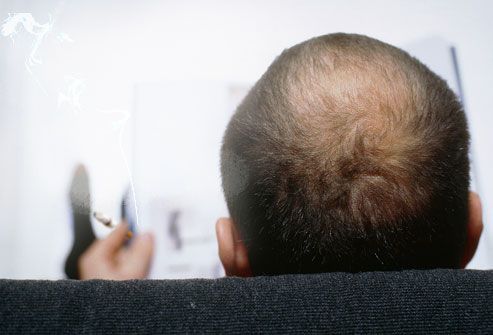 |
| Credit: http://img.webmd.com |
Besides
being the single most preventable cause of significant morbidity and an
important cause of death in the
general population, tobacco smoking also induces premature skin ageing (wrinkles) and grey hair.
Now, Consider Smoking and Baldness.
The
mechanisms by which smoking causes hair loss are multifactorial and are
probably related to
- reduced blood supply to the dermal hair papilla by direct effect on its microvasculature
- damage to DNA of the hair follicle by poisons from smoke, genotoxicants to be exact,
- imbalance in the enzyme systems controlling tissue remodeling during the hair growth cycle,
- pro-oxidant effects of smoking leading to the release of pro-inflammatory cytokines resulting in follicular micro-inflammation and fibrosis
- increased hydroxylation of oestradiol as well as inhibition of the enzyme aromatase creating a relative hypo-oestrogenic state.
While
facial wrinkles or grey hair can be effectively counteracted by current
aesthetic dermatologic procedures, treatment options for baldness (androgenetic
alopecia) are limited*.
Hair Care From Within
Pil-Food
Every
single one of the hair (‘pil’ in latin) found on an average head is made up of
two parts, which are the root and the hair shaft. The root is nourished by
blood via the papilla; while the visible hair shaft is largely made up of a
protein called keratin. Our bodies are incapable of directly absorbing keratin
but can, however, utilise amino acids to produce it. Keratin is also the same
component found in your nails. Therefore, appropriate nutrition is important to
make healthier hair and nails.
Essential
nutrients that may reduce hair loss and strengthen existing hair:
- Sulphurated amino acids. DL-Methionine and L-Cystine are the essential sulphur-containing amino acids that act as the building blocks for the formation of keratin.
- Vitamin B group, especially biotin and panthothenic acid, promote hair growth. The selected combination of B vitamins is essential for the biosynthesis of keratin.
- Vitamin E, a fat-soluble antioxidant, reinforces the protection against inflammatory reaction mediators.
- The hydrolysate of lactalbumin and millet extract complement the action of amino acids. The millet extract is rich in unsaturated fatty acids and contains additional key trace elements. Obtained naturally from millet extract, minerals such as iron, copper, zinc, manganese and iodine can help in preventing scalp problems.
A
variety of factors including inappropriate hair treatment, medication,
radiation, exposure to chemicals, overexposure to sun and sea, hormonal and
nutritional factors, thyroid diseases, skin diseases, stress, and post natal
hair loss can affect hair growth and promote hair loss.
The
nutritional boost for a healthy mane should be taken at the first signs of hair
problems as it prolongs the life cycle of hair and prevents any further
deterioration. It is also important to choose a formula that does not contain
hormone to avoid undesirable side effects such as unintended hair growth in
other areas of the body.
Hair Care from the Outside
Regro contains 5% minoxidil. Minoxidil
has been clinically proven to slow the progression of hair loss and regrow some
hair.
It
is believed that minoxidil works by widening the blood vessels around hair
follicles and opening potassium channels. This allows more oxygen, blood and
nutrients to get to the follicle as well as hyperpolarizing cell membranes --
increasing the strength of the electric field across the width of cell
membranes.
Carin’s Hairpro Scalp Cleanser contains Polygonum Multiforum as the principle
herbalextract to deep cleanse the scalp and remove excess oil and thereby
streghtening and nourishing the hair roots.
NiQuitin has a very popular Online Support Programme that can help you to be
better prepared to fight your smoking temptations.
References:
Trüeb RM. Association between smoking and hair loss: another opportunity for health education against smoking? Dermatology. 2003;206(3):189-91.
Kubo M, Matsuda H, Fukui M, Nakai Y. 1988. Development studies of cuticle drugs
from natural resources. I. Effects of crude drug extracts on hair growth in
mice. Yakugaku Zasshi 108: 971–978.



No comments:
Post a Comment